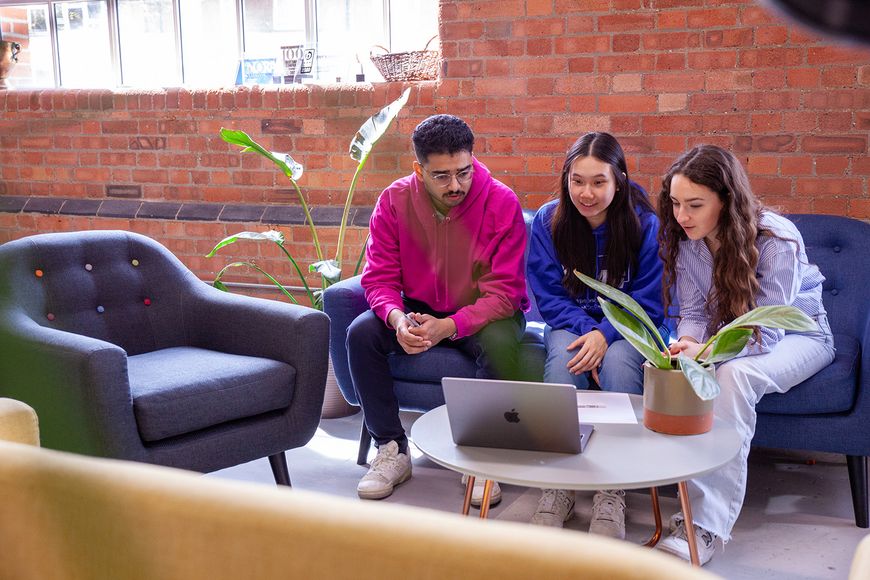
Design Internships
Thinking about a design internship? You’re in the right place. Whether you’re into UX design, graphics or want to be the next Alexander McQueen, an internship in design will give you the skills and experience you need before you graduate. Read on to find out more about design internships, from what they actually are to how much you can earn.

What does a design intern actually do?
As a design intern, you’ll work on real projects as part of an in-house creative team or agency. You’ll gain hands-on experience, get to grips with company technology and work alongside industry professionals. Some types of design internships available can include:
Graphic Design. Creating visual content for brands, from social media graphics to marketing materials
UX/UI Design. Designing digital products and user experiences for apps and websites
Interior Design. Planning and styling spaces, from measuring rooms to selecting furniture
Architectural Design. Working on building designs, technical drawings and planning
Fashion Design. Sketching designs, sourcing fabrics and creating samples
Web Design. Building engaging website layouts and digital experiences.
An internship usually lasts between four weeks and six months (some can last longer) and usually takes place in the summer between your second and third or final year. What you actually do depends on the type of design you’re interested in. But some of the tasks you might work on during your internship can include:
Creating and developing designs
Researching trends, competitors and potential design leads
Using programming languages like HTML, JavaScript, JSP and Java
Creating assets for social and physical media
Attending and contributing to idea gens
Meeting with clients and working on projects
Off-site visits (interior design and architecture, especially).
Are internships worth it?
Absolutely. Graduate jobs can be super hard to get a hold of, so getting work experience before you graduate will go a long way in helping you secure a job or grad role once you’ve finished university.
Outside of just boosting your CV, internships are a great way to discover what it is you want from your design career. You’ll meet loads of different people, including those who could become mentors, future colleagues or even future employers. Internships are all about getting hands-on experience, so you’ll also finish with a portfolio filled with real industry work that you might not get at university.
Ever wanted to know what it’s like to work for M&G Pls? Here’s what one student said about their time as an Architecture Technology Intern:

Personally, I have really enjoyed my internship. It has been an extremely rewarding and eye-opening experience. I have realised that this is the type of company and work I would actually like to do in the future, whereas previously I was a bit unsure of where I was heading with things. I've really enjoyed getting to talk and meet with all the different people in areas of the business. They have all been amazing to talk to and really positive. Architecture Technology Intern, M&G plc
Do I need a portfolio to get a design internship?
100% yes. As you now know, the design industry is super competitive, and a portfolio is the best way to show off your skills, ideas and all the amazing work you’ve been doing while at uni (and outside, too). It doesn’t have to be huge either. Think six to eight really strong pieces of work.
A great portfolio will:
Show your best work
Explain your ideas and include brief, but detailed, descriptions
Be organised and updated regularly.
Don’t already have one? There are some pretty great tools you can use to get started.
If you’re a budding graphic designer, photographer or videographer, Adobe’s Behance is a free website where you can upload your projects. It’s also amazing for some early networking. Canva also has a free portfolio website builder. PortfolioBox is another cool free website builder you can use too. Into architecture or interior design? Archifolio will be your best friend.
Where can I find design internships?
There are loads of employers who are looking for talented interns to join their programmes. Whether you have your heart set on joining a global creative agency or a local start-up, there’s so much out there. Here are some of the top employers hiring design interns:
Here’s how one student felt about their time at NBCUniversal as a product intern:

I was given a decent amount of responsibility in my internship despite having no prior experience in digital product. My colleagues regularly check in and adjust my workload based on my capacity, encouraging growth. At one point, I helped run multiple features, which was both rewarding and allowed me to develop at a manageable pace. Product Intern, NBCUniversal
What skills do I need for a design internship?
You don’t need to be the master of everything before applying. Most employers will expect you to learn on the job; that’s the whole point of an internship. However, there are 200% a few skills that are worth having under your belt. Let’s explore:
Technical skills
Design software. Get to know industry standard software like Adobe Creative Suite for graphic design, Figma or Sketch if you’re looking for roles in UX/UI and AutoCAD or SketchUp for interior design and architecture.
Design principles. Having a good knowledge of colour theory, typography, and layout will go a long way in making sure you have the foundations.
Soft skills
Communication. You'll spend a lot of time working with teams and clients, so being able to explain your ideas clearly matters
Problem-solving. Your job as a designer is to find creative solutions, whether that's fixing a layout issue or rethinking a user journey
Time management. Juggling multiple projects and meeting deadlines is part of the job, so staying organised will help a great deal
Openness to feedback. Your designs will be critiqued (a lot), and being able to take that on board without taking it personally is important.
Click to read more about the most important soft skills for students.
You probably have a lot of these skills already, so you’re 90% there. If you’re still building your skills, don’t worry! Use your second year to get to grips with new and popular programmes; loads of them have free versions (if you don’t already have an account through your uni course).
Lastly, you should probably start getting to grips with AI, too. Hear us out! There are loads of AI tools out there that’ll make your job as a designer easier without sucking the humanity out of your work. AI can help with automating repetitive tasks, idea generation and data analysis. AI isn’t taking over the design world, and there’s plenty of room for talented designers like yourself to shine.
How much do design internships pay?
Most design internships are paid, and you should 200% be putting your energy into finding roles that value your time and hard work. There are still some unpaid internships, but you won’t find those at Higherin.
That said, as a design intern, you could earn between £19,000 and £25,000 pro rata. If you’re working at an agency in London, you’d earn at the higher end of that, with roles typically going between £22,000 and £23,000 pro rata.
How do I apply for design internships?
Start by putting together your CV and internship cover letter, making sure they’re both tailored to each role. Highlight relevant projects, coursework or any freelance work you've done. Employers want to see enthusiasm and potential; they’re not expecting perfection.
Your portfolio will be your secret weapon, so make sure it’s filled with your best work (you can also include moodboards or redesigns of existing projects).
Once you’ve applied, get prepped for the next steps. You’ll be invited to an interview (so practice those internship-specific interview questions) and perhaps an assessment centre, where you’ll take part in design tasks and present your portfolio.
Need help pulling together your application? Check out our application toolkit for templates, tips and everything you need to apply with confidence.
Download your free toolkit























